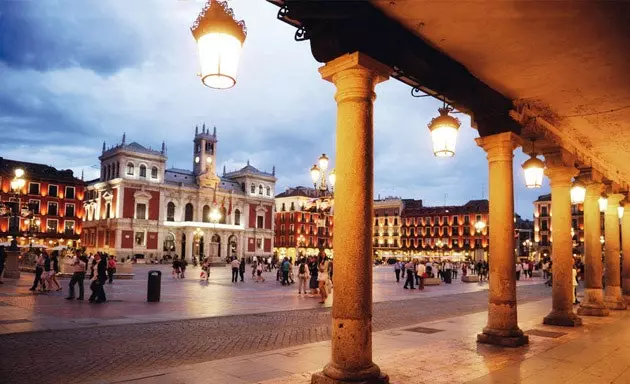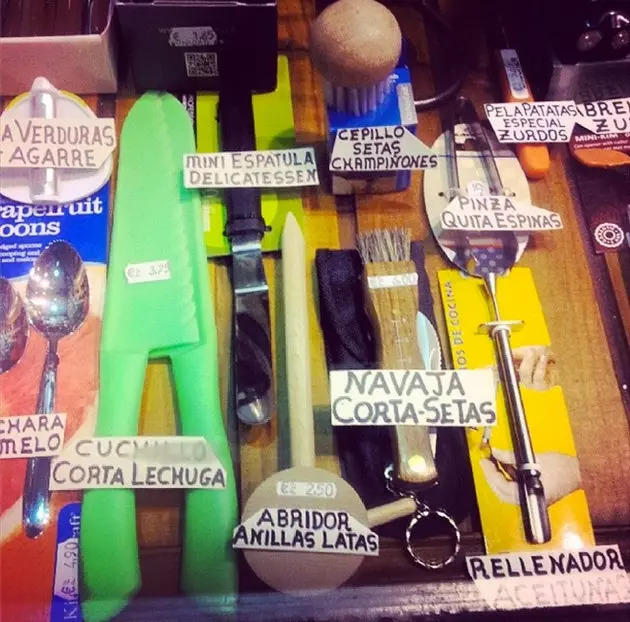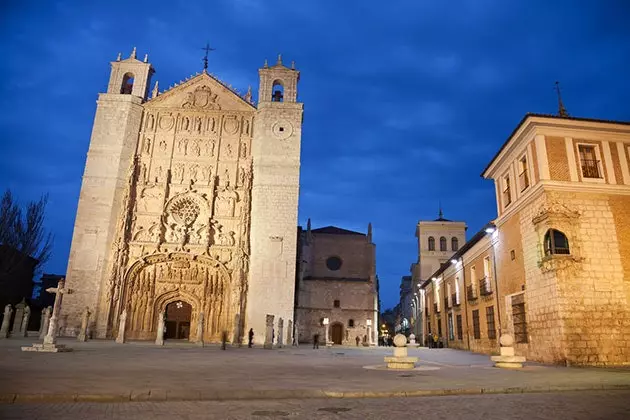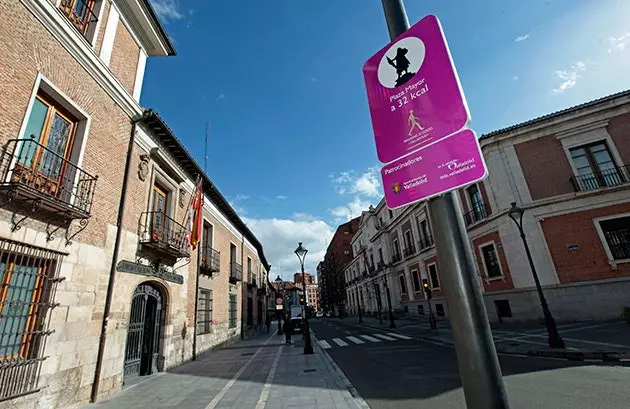
Plaza Mayor of Valladolid at sunset
It's a late winter weekend and The Plaza Mayor of Valladolid is the starting point for slow walks . But not processions like those of spring, because, although a faded sun helps with the photos, the thermometer drops below ten degrees. It is a Valladolid of groups of adolescents with fat jackets and couples of walkers with their hands in their pockets. Everyone could calculate a step of about 5 kilometers per hour. And that is precisely the average speed chosen by the promoters of Walking is good, the initiative that is now starting in Valladolid and that proposes healthy and tourist walks at the same time . There are 21 routes, 20 that start from the Plaza Mayor and one circular. They are signposted at their ends and marked by the kilocalories that a 65-kilo person would consume walking precisely at that 5-kilometer-per-hour march.
The Plaza Mayor of Valladolid It is the starting point of the Walking is good routes. It is almost the entire social life of the city. You stop by here sooner or later to go on a date with a friend or with a tapa. Or to cross to any other part of the city. In recent times, the Plaza Mayor has taken to dressing up as a fair, especially when it gets dark and the carousel parked on one side lights up.
Shortly after, purple lights underline the neoclassical pie lines of City Hall and dozens of spotlights are dyed the earthy red of the houses around them. A festive and light plaza that is no longer exactly that of the last century, which took its character in equal parts from the Sermon of the 7 words of Easter Sunday and from the concerts of Fairs, which also had something of an official sermon (by Olé Olé to Raphael) except when they played Aerolineas Federales or Los Burros and four cats got together there.
But it cannot be said that it has changed so much despite that hard floor on which children do not bounce: there are still the watchmen of the Lion d'Or; Cubero and his models of sweet buildings; La Mejillonera with its mayonnaise overdose ; Juan Villanueva's hardware store and its showcase of kitchen gadgets that do everything for you (from opening the top of a tetra brick to chopping off some strawberries); or El Café del Norte, which houses a silver and baroque cash register that would not be out of place in the Cathedral.

The mills of the Juan Villanueva hardware store
The map indicating the routes has been placed right at the confluence of the square with the pedestrian Calle Santiago, the local strategic headquarters of walks without (much) direction since always (ends in front of Campo Grande) . As the initial idea has more to do with healthy routes than panoramic ones, some of these routes end in places little sought after by tourists, such as the Civic Center of the East Zone (94 kilocalories) or directly to be avoided, such as the Río Hospital Hortega (170 kilocalories) .
The shortest and most photogenic route is the one that reaches the Plaza de San Pablo. On this journey only 32 kilocalories are burned, the equivalent of a tenth of a donette . So we dare to propose that you walk seven or eight kilocalories more, deviate a bit from the marked route, go through Fuente Dorada and its arcades, take the Bajada de la Libertad and do not leave the street until you reach San Pablo.

Saint Paul's Square
By the way, visits the Calderón Theater, which is now 125 years old and the church of Las Angustias, with a way of the cross with a long tradition in the city. Then the ornate Gothic facades of the church of San Pablo and the Colegio de San Gregorio (headquarters of the National Museum of Sculpture), next to the Palacio de Pimentel in which Felipe II was born, make the walk worthwhile.
The other fully tourist route is the one that reaches the Carmelite convent in the Rondilla neighborhood. Its 48 kilocalories they give to eat two plates to the top of lettuce salad without dressing . The path follows a palatial layout in which the most curious thing is the Plaza del Viejo Coso, the oldest bullring, framed then and now by houses. The most current walk on the route is the one that leads to the Valladolid Arts Laboratory (124 kilocalories or six ounces of milk chocolate), a former slaughterhouse and now a cultural space in an avant-garde building, in the style of the Matadero in Madrid. You also get to the dour Monasterio del Prado ( 107 kilocalories or a bag of small potato chips ), the Miguel Delibes Cultural Center (137 kilocalories or half a chocolate donut) and the Science Museum (115 kilocalories or three tablespoons of mayonnaise).
To reach these last three you have to cross the Pisuerga river , crossed by canoeists, surrounded by vegetation (walks and rose gardens) and very instagrammable. The longest walk of all (apart from the circular one) is the one that reaches the Pinar de Antequera Adventure Park. 350 kilocalories are burned on the way, almost a serving of stew if you remove the bacon , but you have to be equipped to travel 7.8 kilometers and take an hour and three quarters.
The truth is that Valladolid is flat and makes you want to walk it. Walking may be one of the slowest ways to lose weight (although much more effective than eating cupcakes, for example), but it is also one of the easiest, the one that involves you more with the environment and the most suitable for a tourist. At the end of all these routes, the visitor has known a much more real Valladolid than the one that would have been obtained only by joining the monumental points on the map. And if you weren't in a hurry, you'll have had some tapas along the way, you'll have hit it off with the natives to reset the myths about the character of Valladolid and you'll know a lot about life in the capital's neighbourhoods. And you may have discovered that fifteen minutes of laughter burns 40 kilocalories.

A walking is good sign
